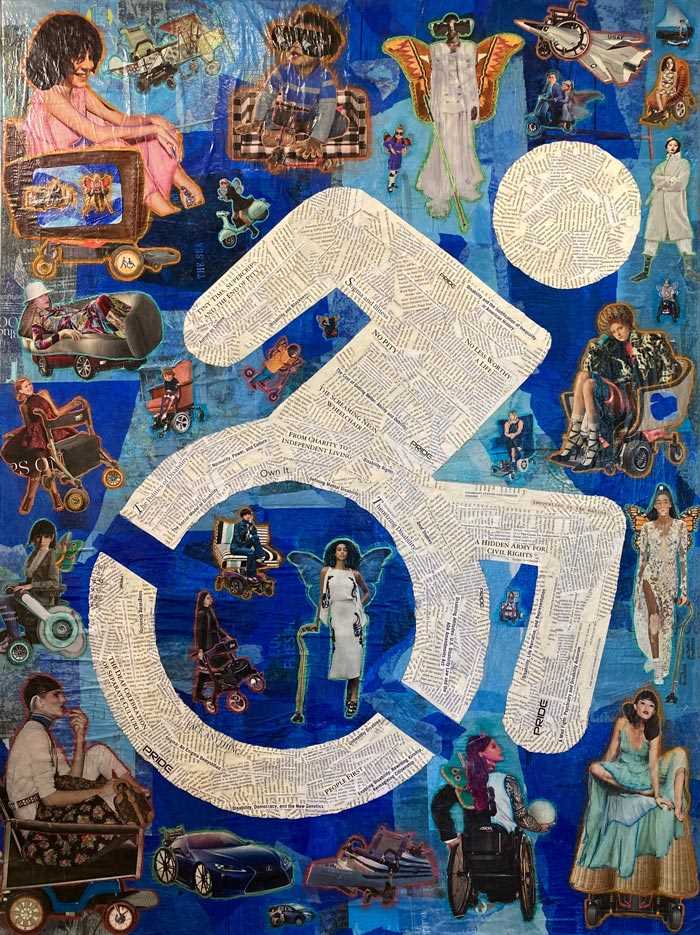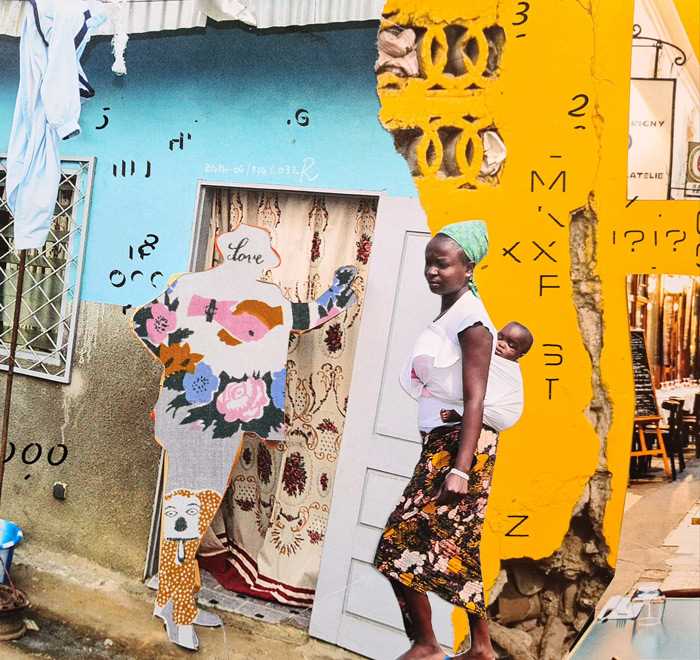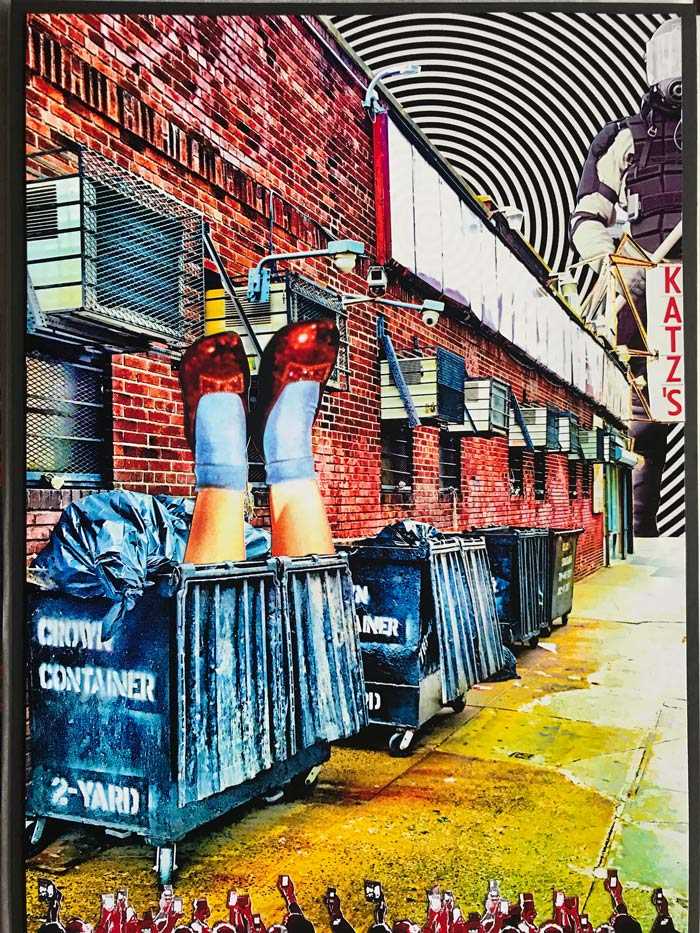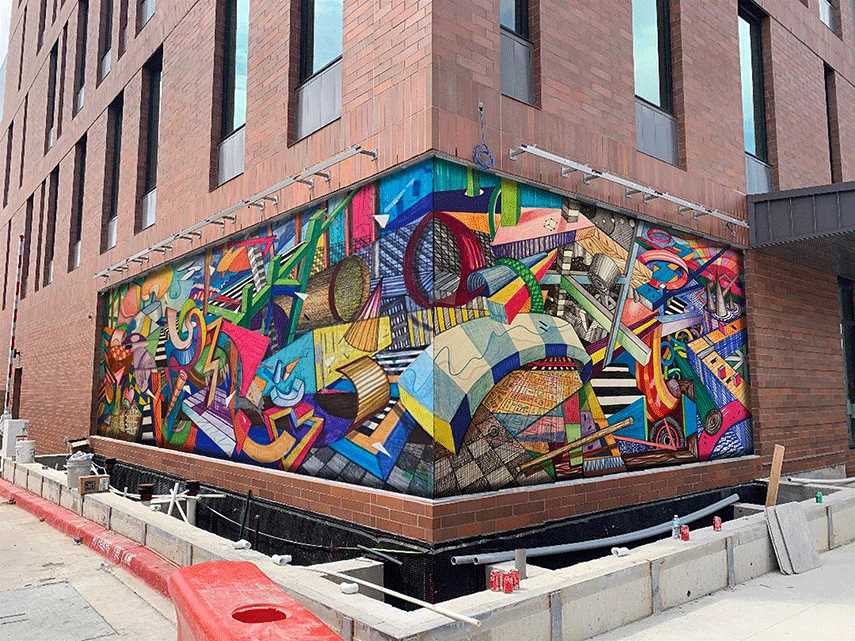
Street art has always been associated with rebellion and self-expression, capturing the essence of urban culture and challenging the norms of traditional art. In recent years, a new form of street art has emerged – urban collage art. This unique art form combines the techniques of traditional collage with the raw energy and vibrant colors of graffiti, resulting in eye-catching and thought-provoking creations.
What sets urban collage art apart from other forms of street art is its ability to bring together seemingly unrelated images and objects, creating a visual narrative that reflects the complex nature of urban life. Artists who specialize in this medium often scour the city streets for materials, collecting discarded posters, flyers, and fragments of torn billboards. These found objects are then meticulously arranged and layered to create a harmonious composition that tells a story.
Urban collage art is not only visually striking, but it also carries a deep message. Through their work, artists explore themes of urban decay, consumerism, social inequality, and environmental issues. They challenge the viewer to question their surroundings and reconsider the impact of their actions. The juxtaposition of contrasting images and symbols adds a layer of complexity to these works, inviting the viewer to delve deeper into the meaning behind the art.
What makes urban collage art so intriguing is its fluidity and adaptability. It can be found on dilapidated city walls, in abandoned buildings, or even on sidewalks. The ephemeral nature of this art form adds to its allure, as each piece is vulnerable to the elements and the constant evolution of the urban landscape. Urban collage art blurs the boundaries between fine art and street art, pushing the limits of what is considered “acceptable” in the art world.
Urban Art: Defining an Ever-Evolving Movement
The world of urban art is a dynamic and ever-evolving movement that continues to push the boundaries of traditional art forms. Combining elements of graffiti, street art, and muralism, urban art represents a unique form of self-expression and cultural commentary.
At its core, urban art is about reclaiming public spaces and challenging the traditional notions of what constitutes art. It is a direct response to the urban environment, often using the city as a canvas and a source of inspiration. Urban artists utilize a wide range of techniques and mediums, including spray paint, stencils, wheatpaste, and even sculptural elements, to create powerful and thought-provoking pieces.
What sets urban art apart is its accessibility and ability to engage with a diverse audience. Unlike traditional art galleries, urban art is accessible to everyone, regardless of their social or economic status. It can be found on the walls of buildings, in alleyways, and even on public transportation. This aspect of urban art allows it to reach a wide range of people and spark conversations about social issues, politics, and urban life.
Urban art also challenges the notion of permanence in art. While traditional art forms are often meant to withstand the test of time, urban art embraces its temporary nature. It is subject to weathering, vandalism, and removal by authorities, which only adds to its ephemeral quality. This transience can give urban art a sense of urgency and a fleeting beauty that resonates with the fast-paced nature of urban living.
The evolution of urban art can be seen in its move towards more collaborative and community-focused projects. Artists often come together to create large-scale murals and public installations that engage with the specific characteristics of a neighborhood or city. These projects not only beautify public spaces but also foster a sense of community pride and ownership.
| Urban Art: | Defining an Ever-Evolving Movement |
Section 2: The Techniques Behind Street Art Collage
Street art collage is a vibrant and dynamic form of artistic expression that involves the combination of various materials, textures, and images to create visually striking compositions. The techniques employed by street artists in the creation of their collages are diverse and often innovative, making use of both traditional and unconventional approaches.
One common technique used in street art collage is the layering of images and materials. Artists may paste or glue different elements onto a surface, creating a multi-dimensional composition that offers depth and intricacy. This layering effect can create a sense of depth and complexity, inviting viewers to explore the artwork more closely.
Another technique used in street art collage is the juxtaposition of contrasting images and textures. By combining elements that might not typically be seen together, street artists create unexpected compositions that challenge traditional notions of art and beauty. This technique can create a visual tension that engages viewers and encourages them to question their preconceived ideas.
Artists may also incorporate stencils into their collage work to create precise and intricate designs. Stencils allow artists to repeat patterns or images multiple times, ensuring consistency and adding a sense of rhythm to their compositions. This technique is often used to create visually impactful and easily recognizable elements within a collage.
In addition to traditional materials like paper and paint, street artists often utilize found objects and recycled materials in their collages. By repurposing everyday objects, artists can add a unique and unexpected element to their work, while also making a statement about consumerism and waste. This approach adds a layer of depth and social commentary to the artwork.
Overall, the techniques used in street art collage are as diverse and varied as the artists themselves. From layering and juxtaposition to the use of stencils and found objects, street artists continually push the boundaries of what is considered traditional art. Through their innovative techniques, they create powerful and thought-provoking compositions that engage and inspire viewers in urban environments around the world.
The Art of Paste-Up: Uniting Urban Landscapes with Art
What makes paste-up such a unique form of street art is its ability to seamlessly unite urban landscapes with art. By carefully selecting the placement and subject matter of their paste-ups, artists can create visual narratives that interact with and complement the surrounding environment.
When creating a paste-up, artists often rely on captivating imagery, bold typography, and vibrant colors to capture the attention of passersby. A successful paste-up not only conveys a message or tells a story but also adds an element of surprise and beauty to the urban setting. By juxtaposing these artistic interventions with the often gritty, concrete surroundings of the city, paste-up artists create a refreshing contrast that challenges traditional notions of art and its place in society.
Furthermore, paste-up allows for a form of artistic expression that is accessible and democratic. Unlike other forms of street art that require spray cans or specialized tools, paste-up can be created by anyone with access to a printer, adhesive, and a willingness to explore their creativity. This accessibility has led to a diverse range of voices and styles within the paste-up community, making the art form a true reflection of the dynamic and multifaceted nature of urban life.
Whether it’s a thought-provoking political statement, a whimsical piece of pop culture, or an intricate artistic design, paste-up brings a new dimension to the world of street art. It not only adds visual interest to our urban environments but also encourages a dialogue between art, public spaces, and the people who inhabit them. So next time you’re walking through the city, keep an eye out for these artistic interventions – they may just inspire you to look at your surroundings with a fresh perspective.
Wheatpaste Collage: A Blend of Tradition and Modernity

Wheatpaste collage is an art form that seamlessly combines traditional techniques with a modern approach. This intriguing art style involves the use of wheatpaste, a mixture of water and wheat flour, as an adhesive to paste various elements together and create stunning collages on urban surfaces.
Origins of Wheatpaste Collage

The origins of wheatpaste collage can be traced back to the early 20th century, when artists began experimenting with pasting printed images and text onto surfaces in urban environments. Initially used as a means of political and social commentary, wheatpaste collage quickly gained popularity as a form of artistic expression.
Artists like John Fekner and Richard Hambleton played a significant role in popularizing wheatpaste collage during the 1970s and 1980s, utilizing the technique to transform dilapidated urban landscapes into vibrant canvases. Their works often featured bold graphics, overlapping images, and thought-provoking messages.
The Modern Approach
In recent years, wheatpaste collage has seen a resurgence in popularity as street art continues to evolve and push boundaries. Contemporary artists have embraced this traditional technique, incorporating it into their works to create visually captivating pieces in various urban settings.
What sets wheatpaste collage apart from other forms of street art is its ephemeral nature. Due to the use of wheatpaste as an adhesive, these artworks gradually fade away over time as they are exposed to the elements. This transience adds a layer of impermanence and evokes a sense of temporality, making it a truly unique art form.
| Advantages of Wheatpaste Collage |
|---|
| 1. Accessibility: Wheatpaste collage can be created using readily available materials, making it accessible to aspiring artists. |
| 2. Versatility: Artists can combine various elements such as photographs, illustrations, and found objects to create dynamic and visually engaging collages. |
| 3. Interaction with the Environment: The ephemeral nature of wheatpaste collage allows it to interact with its surroundings, responding to the changes in weather and the urban landscape. |
| 4. Social Commentary: Wheatpaste collage provides a platform for artists to convey their thoughts and opinions on social, political, and cultural issues. |
As urban collage art continues to evolve, wheatpaste collage remains an influential and versatile art form that bridges the gap between tradition and modernity.
Stencils: Creating Intricate Designs on Urban Canvas

Stencils are a popular technique used by street artists to create intricate and detailed designs on urban canvases. This method involves cutting out a specific pattern or image on a piece of card or plastic, which is then placed onto a surface and spray painted over.
One of the advantages of using stencils in street art is the ability to replicate a design multiple times. Artists can create a stencil once and then use it to reproduce the same image in various locations, creating a visual consistency throughout the urban landscape. This technique is often used by street artists who want to share their message or artwork with a large audience.
Stencil art allows for precise control over the design and composition. Artists can experiment with different shapes, sizes, and patterns to create visually striking and thought-provoking artworks. Additionally, stencils can be combined with other street art techniques, such as graffiti or wheat-pasting, to add depth and dimension to the overall piece.
Another benefit of using stencils in urban art is the ability to quickly and efficiently create large-scale artworks. Unlike freehand painting, stencils ensure clean lines and sharp edges, resulting in a professional and polished finished piece. This allows artists to cover large areas with their designs in a relatively short amount of time.
Stencil art can range from simple and minimalist designs to highly intricate and detailed compositions. Artists often use stencils as a way to convey a message or make a statement about social or political issues. The use of stencils in street art allows for a wider range of artistic expression and can be seen as a democratic art form accessible to both experienced artists and newcomers exploring the urban art scene.
Section 3: The Power of Street Art Collage

Street art collage is a powerful form of artistic expression that combines various elements, textures, and mediums to create visually stunning and thought-provoking works of art. Through the juxtaposition of different elements, artists are able to convey powerful messages and evoke emotion in the viewers.
1. Creating Depth and Dimension

One of the key advantages of using collage in street art is the ability to create depth and dimension in the artwork. By layering different materials and images, artists can add texture and complexity to their work, making it visually striking and engaging. This technique allows the artwork to come to life and almost jump off the wall.
2. Embracing Diversity and Cultural Identity

Street art collage often incorporates elements from different cultures, embracing diversity and celebrating the rich cultural heritage of communities. Artists use this mix of cultural references to challenge societal norms, highlight social issues, and promote unity and understanding among diverse groups of people. The use of collage allows artists to seamlessly integrate these diverse elements, creating a visual representation of the complexity and beauty of different cultures.
| Benefits of Street Art Collage | Examples |
|---|---|
| Engages the viewer | Collage art that incorporates interactive elements or hidden messages |
| Creates a sense of place | Collage art that incorporates local landmarks or symbols |
| Provokes thought and discussion | Collage art that tackles controversial topics or social issues |
Overall, street art collage is a powerful tool for artists to express themselves, communicate important messages, and contribute to the vibrant and diverse world of street art.
Posters and Their Impact in Urban Spaces

In the vibrant world of street art, posters play a crucial role in shaping the urban landscape and the way we perceive our surroundings. With their bold colors, striking graphics, and thought-provoking messages, posters have the power to captivate the attention of passersby and evoke a sense of curiosity.
Posters, often displayed on walls and buildings, serve as a form of visual communication that can convey powerful messages, express social commentary, or promote events and artistic endeavors. They can be found in various forms and sizes, ranging from simple wheatpastes to large-scale murals.
One of the key attributes of posters is their ability to engage with the public. Unlike other forms of street art that may require a closer inspection, posters are easily accessible and can effectively communicate their message in a split second. Whether it’s a political statement, a call to action, or an expression of artistic creativity, posters can capture the attention of a diverse audience and ignite conversations.
Posters also have the advantage of being easily removable and replaceable, allowing artists to continuously refresh the urban landscape and keep up with the dynamic nature of the city. This flexibility ensures that street art remains a vibrant and ever-changing art form that reflects the evolving social, cultural, and political climate.
In addition to their artistic value, posters also serve as a medium for cultural expression and representation. They can embody the spirit of a neighborhood, celebrate its history, or showcase the diversity of its residents. By featuring the works of local artists, posters contribute to a sense of local pride and identity.
Moreover, posters can also create a sense of discovery and exploration in urban spaces. As passersby encounter these visual delights, they are invited to pause, reflect, and engage with their surroundings. The experience of discovering a thought-provoking poster can turn a mundane walk into an inspiring journey.
Overall, posters have a significant impact on urban spaces. They facilitate artistic expression, spark conversations, reflect cultural identity, and invite people to engage with their environment in a more meaningful way. Their ability to add vibrancy and character to the streetscape makes them an integral part of the diverse world of street art.
Graffiti and Its Role as a Unique Form of Expression

Graffiti, often seen as a form of vandalism, is actually a unique form of expression that has evolved into a legitimate art form. In urban environments around the world, graffiti artists use public spaces as a canvas to create vibrant and thought-provoking works.
One of the reasons graffiti is so unique is its ability to convey messages that might otherwise go unnoticed or silenced. It offers a platform for individuals to express their opinions, frustrations, and dreams, giving voice to those who may not have the means or opportunity to be heard in other forms of media.
Graffiti also challenges traditional notions of art by breaking free from the confines of galleries and museums. It brings art directly into the streets, making it accessible to a wider audience. This democratization of art allows people from all walks of life to engage with and appreciate the creativity and talent of graffiti artists.
Moreover, graffiti often reflects the cultural and social issues of its surroundings. It serves as a visual commentary on the environment, politics, and society in which it exists. By using symbols, colors, and images, graffiti artists can communicate complex ideas and emotions, provoking thought and sparking conversations among the viewers.
Additionally, graffiti has the power to transform spaces. It can turn dull and forgotten walls into vibrant and captivating works of art, revitalizing neighborhoods and creating a sense of community. Many cities now embrace graffiti as a valuable cultural asset and have designated areas where artists are free to create, fostering a sense of pride and identity within the local community.
Tags: The Personalized Signatures of Street Artists

One of the key elements of street art is the use of tags, which are the personalized signatures or signatures of street artists. Tags serve as a form of identification and are often unique to each artist, allowing them to leave their mark on the urban landscape.
Tags are typically stylized and can range from simple initials to elaborate designs. They are frequently created using graffiti markers or spray paint, and are often placed in prominent locations where they can be easily seen by passersby. Tags can be found on walls, doorways, trash cans, and other surfaces throughout cities around the world.
While some people may view tags as acts of vandalism, they are an integral part of the street art movement. Tags allow artists to claim ownership of their work and create a sense of identity within the urban art community. They also serve as a form of communication between artists, with tags sometimes referencing specific artists or crews.
The Evolution of Tags
Tags have a long history within the graffiti and street art world. In the early days of graffiti in New York City, tags served as a way for artists to mark their territory and establish their presence in the city. Over time, tags evolved from simple monikers to more elaborate designs, with artists experimenting with different lettering styles and incorporating symbols and images into their tags.
Today, tags continue to evolve as artists push the boundaries of what is possible with their personalized signatures. Some artists have even taken their tags to the digital realm, creating virtual tags that can be seen online or in augmented reality experiences. This fusion of technology and street art allows artists to reach a wider audience and explore new ways of expressing their creativity.
The Significance of Tags

Tags are an important aspect of street art culture as they allow artists to leave their mark on the urban landscape. They signify the presence of the artist and serve as a reminder of their existence. Tags also contribute to the overall visual aesthetic of the city, adding a layer of color and creativity to otherwise mundane environments.
While tags may not always be understood or appreciated by the general public, they are an integral part of the street art movement and the culture that surrounds it. They represent the individuality and creativity of the artists who create them, and they serve as a symbol of the ongoing dialogue between artists and their environment.
Section 4: Exploring Street Art Collage Techniques

Street art collage is a dynamic and expressive form of artistic expression that combines various elements to create stunning visual compositions. Artists use a wide range of techniques to create their unique collages, blending photographs, illustrations, typography, and found objects to create a multi-layered and visually captivating artwork.
One popular technique in street art collage is the use of wheatpaste. Wheatpaste is a mixture of flour and water that is used as an adhesive to stick paper onto walls or other surfaces. Artists apply the wheatpaste to the surface and then carefully arrange their collage elements, such as torn pieces of posters, photographs, or magazine cutouts. This process allows the artist to create large-scale collages that can transform urban spaces into immersive and thought-provoking artworks.
Another technique commonly used in street art collage is stenciling. Stencils are pre-cut designs that artists can use to create repeated images or patterns. By using stencils, artists can quickly and easily reproduce their designs on various surfaces. They can combine stenciled elements with other collage materials to add depth and complexity to their artwork.
Found object collage is yet another technique that street artists employ. This technique involves incorporating everyday objects, such as discarded materials found on the streets, into the collage. These objects can range from pieces of wood or metal to old signage or broken toys. By repurposing these objects in their collages, the artists create a dialogue between the urban environment and their artwork, transforming mundane objects into symbols of creativity and expression.
Moreover, mixed media collage is a versatile technique that allows artists to explore different materials and textures. Artists can combine various elements, such as paint, markers, fabric, or even three-dimensional objects, to create a visually dynamic collage. This technique gives artists the freedom to experiment and push the boundaries of traditional collage, resulting in unique and visually engaging artworks.

I am a mural enthusiast and a fervent admirer of street art. Rather than creating murals myself, I am passionate about collecting them. My love for street art knows no bounds. I am dedicated to curating and cherishing these artworks that grace the streets. My collection stands as a testament to my profound appreciation for this form of artistic expression.
read about me



